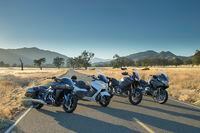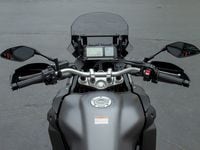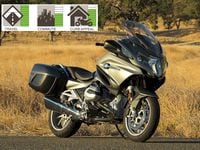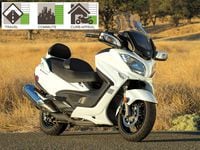California’s Highway 58 is a lot of things. A challenging, 75-mile-long ribbon of asphalt and concrete connecting the central and coastal valleys. A roller-coaster ride through oak-spotted grasslands punctuated by dusty grazing cattle and gleaming solar farms. And one of our favorite roads for evaluating motorcycles because it’s half a day’s ride from our HQ and a gateway to some of our state’s most desirable attractions: cool coastal roads, kitschy/quaint hotels, and a brewpub or two.
It is not, however, a road oft populated by scooters. And yet here we are, four distinctly different two-wheelers ridden as a group and keeping a respectable pace—the fellow on the sport-touring rig laughing into his Bluetooth intercom about the guy on the scooter harassing the rider on the cruiser, who themselves are giggling like a couple of schoolboys who just discovered Penn and Teller.
From the outside, it must look like we got our texts auto-corrected into incomprehensibility, causing each of us each to bring the wrong bike. How else would you explain a big scooter, a large ADV bike, a bagger, and a sport-touring machine hanging together?
Call it a noble experiment, catalyzed by your editor-in-chief rambling on about a recent trip on BMW’s latest R 1200 RT and how it was the perfect long-distance machine for the rider who doesn’t want to give up every millimeter of sporting capability. The “boys”—editors Ari Henning and Zack Courts —politely scoff at the EIC’s bromance with the “old man’s machine” and suggest that you could do serious miles on pretty much any motorcycle and be happy. Even a scooter.
Only one way to find out.
Joining the incredibly capable BMW, which we voted as the Best Touring Bike in our 2014 Motorcycle of the Year awards and has since returned to our testbike fleet after getting a new rear shock, are three machines representing segments that we think overlap the conventional definition of a sport-tourer. From Honda, we nabbed a CTX1300 Deluxe. The last time we had one, we pitted it against a very traditional midsize touring cruiser [(see CTX 1300 Deluxe vs. V-Star 1300 Deluxe here)][], but for this story we'll have it stand in for bikes like the Harley-Davidson Road Glide. Call them modern baggers—sophisticated in their own way, meant to be comfortable and stylish, sometimes a difficult balance to manage. Because adventure tourers have "tour" right in the name, we nabbed a Yamaha Super Ténéré ES to represent the segment. Just as the CTX stands in for a wide range of baggers, the Super T will have to act like bikes as disparate as the BMW GS and the Triumph Explorer 1200. And even though BMW's mega-scooters are the latest in the category, we wanted to reacquaint ourselves with Suzuki's biggest Burgman, the 650.
Once we’d decided on the machines, it was a matter of gathering humans and hitting the road. Along with your intrepid EIC, staffers Ari Henning and Zack Courts, and photographer Kevin Wing (strategically placed on the EIC’s long-term Suzuki V-Strom 1000 to pile on the miles), came friend of the MC family John Young. John’s day job involves another BMW R 1200 RT, only painted black and white with a place for a gun and a ticket book. But we didn’t borrow him for the badge: You see, he’s a hard-core moto enthusiast with a long line of bikes in his past. His current ride is a Ducati Multistrada Pikes Peak. Our kind of guy.
So the four of us set out through Los Angeles looking for the first marks of separation among these machines besides price—$11,000 to just shy of $22K. As expected, the Burgman rocks because it’s fantastically easy to ride. Roll open the throttle and the Suzi’s 683cc four-stroke twin gets right to business, thanks in part to a responsive and effective CVT (continuously variable transmission). When in the basic mode, which the Burgman reverts to when started, the CVT holds engine speed near torque peak during acceleration and then lets revs drop during steady-state riding; a performance mode allows more revs during acceleration, and there’s a “manual” mode that gives you the choice of six ratios. Ask for more speed and the CVT chomps down, revs shoot up with a barely discernible parallel-twin buzz, and the Burgman strides ahead. Saying that it leaps is a stretch, but it has no trouble keeping up with traffic even while the 50-liter storage bin under the seat is full of Zack’s, uh, junk.
Upon our choked freeways, the other three gridded closely. Despite fairings and windshields and hard bags, there were scant differences in the way the BMW, Honda, and Yamaha tackled the urban escape. Sure, the Yamaha feels a little larger than it needs to be—the bars are wide and the bags seem girthier than is sensible—and the BMW’s wall of plastic is intimidating at first, but all found their way to the open highway without a scratch. If we were asked to recommend a pure commuter, it would be the Burgman or a smaller machine like Honda’s NC700X or a Yamaha FZ-07.
Open roads exposed the strengths of the bigger machines. “Man, this RT is fantastic,” Officer John gushed at the first fuel stop. “If my department doesn’t get these to replace our old RTs, I might have to buy one myself.” No doubt he’d found just the right position for the electrically adjustable windscreen, dialed in a favorite station on the satellite radio, and clicked the cruise control to some supra-legal speed, the ticket for which he might be able to talk his way out of. Few bikes are as adept at chugging down the miles as the RT, thanks to a near-perfect riding position and a flexible, suitably smooth water-cooled Boxer engine. If it were legal to hammer along secondary roads at 100 mph for 200-plus miles at a clip, this machine would be our first choice. We can’t overstate how much more life this generation of RT contains thanks to the new, lighter, more powerful drivetrain.
Sighting the pearl-white Burgman among our obviously travel-ready trio—plus the thoroughly overloaded V-Strom… Thanks, Mr. Wing—was disconcerting at first, like espying a kindergartner who snuck onto the middle-school playground. But the scoot worked well. There’s enough power to pass, most of the time, and the short-travel suspension and small wheels (15-inch front/14-inch rear) manage smoother pavement with aplomb. Even the riding position is fine, thanks to very long floorboards that give you positions from nearly standard to quite feet-forward cruiser-ish.
Despite the low windscreen, the CTX provides ample weather protection. Our taller riders had their heads in full airflow, but the separation from the lower body is smooth, meaning no turbulence. “When I first laid eyes on that chopped screen I thought for sure at 80 mph it was going to feel like my helmet was in a paint shaker,” Zack said, “but that wasn’t the case.” Ari agreed: “For a cruiser/bagger, it’s really good. I liked the layout, and the seat is soft enough that it’s a valuable member of the suspension system.”
We all came to grips with the cruiser-style riding position because it’s not extreme. Your feet are mildly forward, the bar comes back at you but isn’t in your lap (or at your earlobes), and the seat is long and flat. In a word, relaxing, which aptly describes the rest of the CTX’s demeanor. The silky longitudinal V-4 hums between your kneecaps, producing a swell of torque with nary a whitecap. Although you’ll find just five ratios in the slick-shifting gearbox, they’re separated well and served by that wall of torque. Crank open the throttle and the Honda pushes you into the seat bolster with pleasing authority, a bit of intake growl and exhaust noise adding to the scene. Very un-Honda-like, now that we think about it.
If the Honda is reserved, the Yamaha is nearly asleep. Changes to the 2014 Super T netted a little more power and some additional pound-feet, but the engine’s character remains unchanged. Laconic. Stoic. Workmanlike. You won’t want to—nor do you need to—rev the Super T’s 1,199cc parallel twin to the redline. A 270-degree crank configuration helps give the engine just a shimmer of personality. Just. And yet there are two sides to this argument: An in-your-face machine can become tiresome at the end of a long day, so this is actually what you want when it’s lunchtime and there are still 500 miles to travel. On that basis, the Super Ténéré obliges—not just with a smooth, restrained power delivery but with very soft suspension calibration and deliberate steering that ignores your little jitters and flinches. At a street pace, the Super T is unflappable.
The BMW’s new-for-2014 RT platform allows the pegs to be closer together—thanks to the new liquid-cooled engine—so they can be lower. Result? A comfortable but still reasonably compact position that places remarkably little stress on the human body but also maintains a strong sense of control. For its part, the Super T is much like that, just larger and rangier in every dimension. “Upright and lots of room; good for tall guys like me,” Zack said, and he wasn’t alone in being happy. “The seat is great and the bars are in the right place,” Ari opined. While we all found some combination of the two seat heights and the continuously adjustable windshield on the R 1200 RT to provide the right combination of coverage and smooth air, that wasn’t so on the Super T, whose windscreen really only worked for some of our riders. Others got a neckful of turbulence. “Turbulence galore, and that windscreen is ridiculously difficult to adjust,” Ari said. Zack countered, saying, “it works pretty well for me; not dead smooth around my helmet, but it takes the majority of wind off my chest, which makes cruising at freeway speeds quite comfortable.”
Finally our route intersected roads intended to liberate the inner hooligan. We expected the Burgman to be the tail ender, the last choice. Just watch the Burgman charge through corners, sparks glinting from the centerstand feet. Momentum is the name of the game for the Burgman pilot, since it’s heavy and down on power, but with a bit of body English and smooth lines, the Suziscoot can be made to haul.
If the Burgman looks out of place on a twisty piece of tarmac, then the big blue CTX is an even odder sight; watch the rider squirm to keep his feet to the inside of the pegs and witness road debris and bits of the footpegs come flying back toward you. Fact is, the Honda made good time, thanked to a torquey engine, amazingly good handling, and phenomenally effective brakes. Like a lot of cruisers, the cornering clearance is some distance shy of the chassis’ capabilities, so making any kind of time is a matter of upper-body position and riding to preserve lean angle.
Remember that our natural sense is to emphasize the sport side of the sport-touring equation, and that’s exactly where the BMW and Yamaha pull away from the Honda and the Suzuki. Incrementing up the pace or encountering ever-bumpier roads generates demands that the CTX and Burgman can’t quite meet. But the other two do so easily.
“I was amazed how much worse the RT felt at low speed than the Burgman and Super T. It was much more comparable to the CTX at anything under 5 mph. Above 5 mph, however, the weight balances out and becomes incredibly neutral. It feels like it weighs 200 pounds less on a twisty section of road,” Zack said. Officer John agreed, saying, “I’ve read what an improvement this bike is over the previous generation, but you don’t truly understand that the RT has taken an immense leap until you ride one. As for amenities, it has everything I could ever want on a motorcycle.”
One stretch of road, which we found totally by accident, and made up of pockmarked, weather-heaved, unmaintained blacktop helps underline the class distinctions. You can’t really blame the scooter for behaving badly on a really rough, fast road; it’s meant for comparatively smoother urban environments and much lower speeds. Same for the Honda, whose short-travel suspension is fine on smooth roads but lacks both the control and travel necessary to flatten bigger imperfections.
Both the RT and the Super T handled this nasty stretch of pavement with ease—the Yamaha through a reasonable amount of too-soft travel and the BMW through the miracle of electronics. For its part, the BMW’s Dynamic ESA gives it a combination of compliance and comfort you’d expect from a touring rig along with control that rivals (and in many cases exceeds) that of the Super T. Yamaha’s “ES” version of the Super T has electrically adjusted conventional suspension, and that’s convenient, but the BMW’s constantly adapting system is functionally superior. Period.
Over the course of three days that included hundreds of miles on the interstate, countless backcountry corners, a good bit of urban riding, and a week’s worth of tomfoolery, we came to more than a few conclusions. First is surprising praise for the Burgman. It’s not a great touring machine—for one thing, it lacks range, as in 188 miles to a dry fuel tank. But overall the Burg is about 1,000 percent better than it has any right to be. If you owned one as a commuter and had an invitation to visit friends 300 miles away for the weekend, it would do just fine. Trust us.
We’re also more impressed with the Honda than we have been in the past, partly because it’s a relaxing, comfortable partner for smoother, straighter roads. Touring in the heartland of our country would fit the Honda to a T. Its compact yet capacious luggage (70 liters total) is generally well done, and we appreciate the audio option on our Deluxe model.
But for our money, it’s hard to go wrong with either laser-guided specificity or broad utility. BMW has refined the RT concept so thoroughly that there’s hardly anything left to criticize but the heft that comes with the amenities; and even then the burden is a reasonable 40 pounds over the Yamaha Super T, which, it might surprise you, is the lightest of the four bikes here. If your voyages of pleasure do not include more than a few hundred yards of dirt, the RT is the way to go: You get unparalleled weather protection, integrated luggage, cruise control, and a hundred other small things that reveal decades of refinement.
Motorcycling has been taken to task by our elders who remind us that a sport-touring motorcycle was just a motorcycle with a duffel bag on the seat and an extra set of spark plugs under the sidecover. Today’s technologically sophisticated two-wheelers are specialized almost beyond recognition, but they maintain an important linkage to the past: With the right attitude and a sense of adventure, you can travel, tour, escape on just about anything. Even a scooter.
ZACK COURTS ASSOCIATE EDITOR AGE: 31 HEIGHT: 6'2" WEIGHT: 185 lb. INSEAM: 34 in.
This, to me, is quintessential motorcycling. It doesn’t matter what kind of bike you ride. It’s the journey, not the destination. I’m not sure if Honda meant to or not, but what it created in the CTX1300 is an amazingly versatile bike—cool enough to drift down main street in a scofflaw slouch yet comfortable and capable enough to get lost for a weekend. BMW’s RT is arguably motorcycling perfection, but if I were going to send Bavaria that much money I’d get the six-cylinder, adaptive-headlight, shock-and-awe K1600.
Most impressive, without a doubt, was the scoot. The Burgman did basically everything the other bikes did (except accelerate with any urgency), with poise and grace, for a fraction of the sticker price. Plus, unlike the Super Ténéré, it’ll keep you from going all Ewan McGregor down a dirt road and ADV’ing yourself onto YouTube. Three cheers for scooters: Hip, hip!…
ARI HENNING ROAD TEST EDITOR AGE: 29 HEIGHT: 5'10" WEIGHT: 171 lb. INSEAM: 33 in.
When the boss proposed a tour on this motley crew, I had my doubts. The cruiser and the scooter would surely be the penalty boxes that nobody wanted to ride, and how the heck were those bikes going to keep up on some of the super-challenging roads Marc had mapped out?
As it turns out, nobody minded riding either of the quasi-recumbents. I was the one who ended up knees together on the Burgman on some seriously technical roads, and I had a blast! It’s a good thing there were already fires burning in Hunter Liggett (controlled burns gone out of control) because the Veggie Burger was trailing sparks. With a little more ground clearance (taking the centerstand off would do it), the Burgman could really rail. Ground clearance was the CTX’s biggest handicap, too, but besides that the Honda was a pleasure to ride and seemed well suited to touring.






























/cloudfront-us-east-1.images.arcpublishing.com/octane/2WF3SCE3NFBQXLDNJM7KMXA45E.jpg)
/cloudfront-us-east-1.images.arcpublishing.com/octane/G4MG6OUCJNBSHIS2MVVOTPX65E.jpg)
/cloudfront-us-east-1.images.arcpublishing.com/octane/IIGGWFOTOJGB7DB6DGBXCCMTDY.jpg)
/cloudfront-us-east-1.images.arcpublishing.com/octane/QSTCM6AVEZA5JJBUXNIQ3DSOF4.jpg)
/cloudfront-us-east-1.images.arcpublishing.com/octane/U4I7G625B5DMLF2DVIJDFZVV6M.jpg)
/cloudfront-us-east-1.images.arcpublishing.com/octane/B6XD6LS6IVCQPIU6HXDJSM3FHY.jpg)
/cloudfront-us-east-1.images.arcpublishing.com/octane/ICL63FEDDRDTTMINYICCEYGMDA.jpg)
/cloudfront-us-east-1.images.arcpublishing.com/octane/FCGZHQXRBZFLBAPC5SDIQLVF4I.jpg)
/cloudfront-us-east-1.images.arcpublishing.com/octane/WNOB6LDOIFFHJKPSVIWDYUGOPM.jpg)

/cloudfront-us-east-1.images.arcpublishing.com/octane/X33NU3E525ECRHXLNUJN2FTRKI.jpg)
/cloudfront-us-east-1.images.arcpublishing.com/octane/6KKT5NNL2JAVBOXMZYS5ZO76YA.jpg)
/cloudfront-us-east-1.images.arcpublishing.com/octane/J5RKG5O455GMPGQRF2OG6LRT7A.jpg)
/cloudfront-us-east-1.images.arcpublishing.com/octane/GX2CIZKQVRH2TATDM26KFG2DAE.jpg)
/cloudfront-us-east-1.images.arcpublishing.com/octane/ZWIDYSAKQZHD5BHREMQILXJCGM.jpg)
/cloudfront-us-east-1.images.arcpublishing.com/octane/CYUHJZCTSJCH3MRAQEIKXK7SCQ.jpg)
/cloudfront-us-east-1.images.arcpublishing.com/octane/LKOFINY56FCXJCANJ5M7ZDQUBY.jpg)
/cloudfront-us-east-1.images.arcpublishing.com/octane/4NBPDACMWJH63JQYJVK3QRBDZI.jpg)
/cloudfront-us-east-1.images.arcpublishing.com/octane/KKHQHRR3FJGX7H2IPU6RALMWG4.jpg)

/cloudfront-us-east-1.images.arcpublishing.com/octane/5IOFS5JAE5FOXMNA23ZRAVVYUU.jpg)
/cloudfront-us-east-1.images.arcpublishing.com/octane/CGXQ3O2VVJF7PGTYR3QICTLDLM.jpg)

/cloudfront-us-east-1.images.arcpublishing.com/octane/OQVCJOABCFC5NBEF2KIGRCV3XA.jpg)